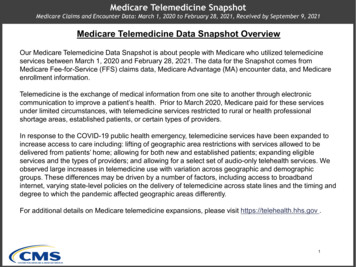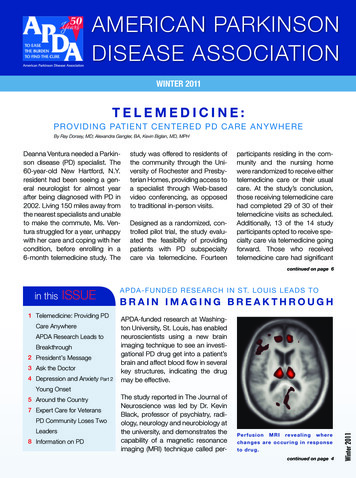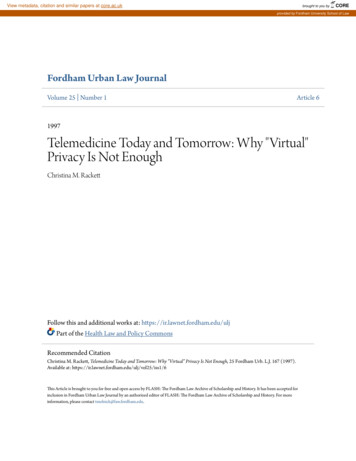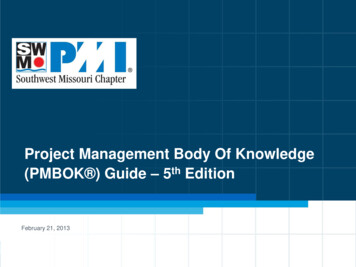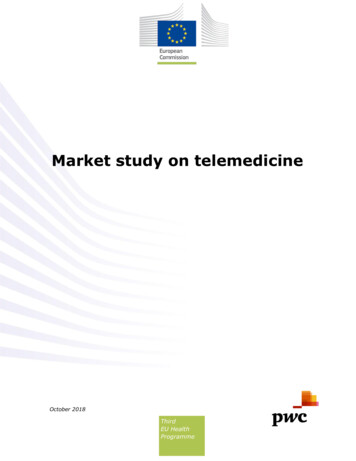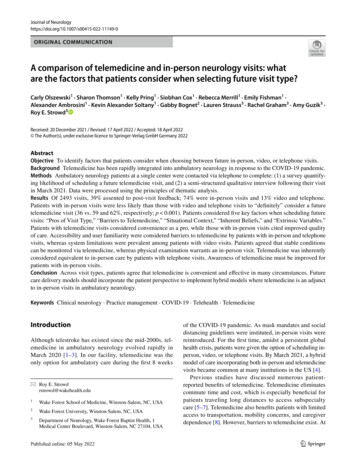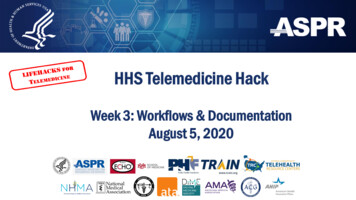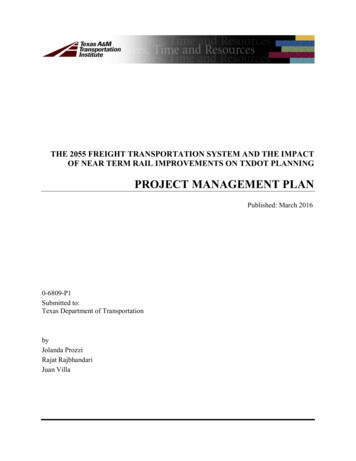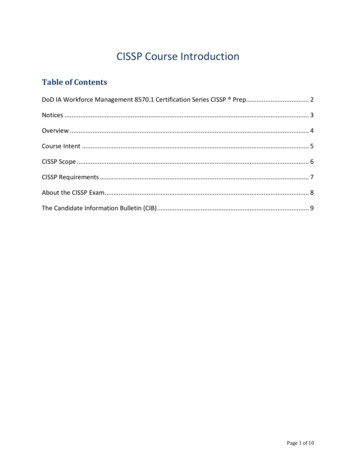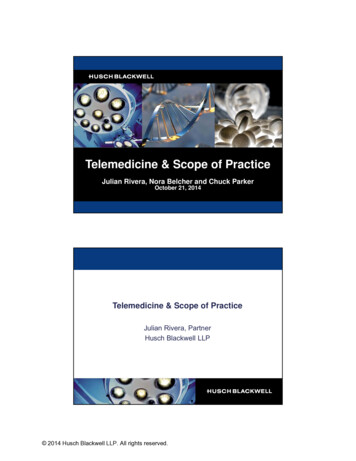
Transcription
Telemedicine & Scope of PracticeJulian Rivera, Nora Belcher and Chuck ParkerOctober 21, 2014Telemedicine & Scope of PracticeJulian Rivera, PartnerHusch Blackwell LLP 2014 Husch Blackwell LLP. All rights reserved.
Overview Pressing RealitiesOpportunitiesRegulatory StructuresScope of PracticeRisk ManagementPressing Realitiesof Traditional Practice Models Declining volumes, margins Value-based, population health– Patient selection (acute/chronic) Data Analytics– Regulator, Payor, Practice Retail Medicine– Price shopping, narrowing networks, exchanges 2014 Husch Blackwell LLP. All rights reserved.
Telemedicine OpportunitiesEfficacyThe Empirical Foundations of Telemedicine Interventions for Chronic DiseaseManagement, Telemedicine & e-Health, Bashshur, et. al., 2014 Results: Chronic diseases managed with telemonitoringprovided fewer and shorter hospital admissions, feweremergency room visits, less severe illness and reduction inmortality. CHF: Tele-monitoring coordinated system of care chronic Stroke: tPA during Golden Hour, CT scan early - acute COPD: telespirometry (lung function) – specialists byteleconsultations 2014 Husch Blackwell LLP. All rights reserved.
Telehealth & Telemedicine OpportunitiesTechnology is Changing Patient Behavior mHealth is driving consumer demand – technologically sophisticatedpatiento AppleHealthKit Duke and Stanford, prominent US hospitals are planning trialsfor chronic disease patientso“Talk to a Doctor Now” search service Scripps Health & One Medical Group Most hospitals already provide care by video & static data delivery Brand loyalty/engagement - “stickiness”Courtesy of Dartmouth-Hitchcock 2014 Husch Blackwell LLP. All rights reserved.
Telemedicine Reimbursement Inconsistent Insurance Requirements & Payment Streams Study & Negotiate Reimbursement Policies Caution that claims submitted are compliant with payor policy American Telemedicine Association (ATA) 50 State Survey California Telehealth Resource Center Reimbursement Guide Clinical/Financial/Technological Systems Integrations (ACO) System design and responsibilities Anti-Kickback, Stark, Antitrust, State referral lawsTelemedicine Regulatory StructuresFDA – medical devicesFCC – wireless spectrumOCR – HIPAA/HITECHFTC – Breach Notification RuleOffice for National Coordinator for Health InformationTechnology – standard development and coordination DEA – no controlled substances without in-person exam Armed Forces – federal employees not subject to stateregulation (innovation) International – regulations of country (provider/patient-based) ̶ Foreign Corrupt Practices Act (FCPA) 2014 Husch Blackwell LLP. All rights reserved.
Telemedicine Regulatory StructuresFederation of State Medical BoardsProposed changes require state approval (legislaturesand medical boards) Model Telemedicine Policyeliminates in person face-to-face Interstate Medical Licensure Compactstreamlined application process 2014 Husch Blackwell LLP. All rights reserved.
Telemedicine Regulatory Structures Texas by Example: Established Medical Site: hospital or clinic with requiredmedical professionals and equipment Licensed or certified Patient Site Presenter No limitations on type of care Standards are same as traditional in-person setting Initial and follow-up visits Distant site provider may treat new condition with 72 hour physicianface-to-face follow-up if condition continues Follow-up: videoconferencing with live feed from patient home Initial diagnosis made in person or at Established Medical Site On-Call: physicians of same specialty & provide reciprocalservice may provide on-call care for each other’s active patients 2014 Husch Blackwell LLP. All rights reserved.
Scope of Practice Scope of Practice Issues – “Top of the License” Definition of the practice of medicine Medical Practice Act Supervision of non-physician providers Independent diagnosing and prescribing Prescriptive Authority Agreements Telepresenters: licensed or certified Pharmacists Retail: “Big Box” stores 2014 Husch Blackwell LLP. All rights reserved.
2014 Husch Blackwell LLP. All rights reserved.
Telemedicine Risk Management Compliance Program––––Contractual arrangementsPrivacy & security around data transmissionEmail, text and websitePhysician-patient relationship (initiation &termination)– Informed consent– Continuity of care (referral & on-call)– Medical records Substance abuse treatment records– System integrity– FCPA - International 2014 Husch Blackwell LLP. All rights reserved.
Telemedicine Risk ManagementOperational Standards Standard of care Clinical standards/algorithms Administrative standards Organizational Provider Technical standards Vendor relationships 2014 Husch Blackwell LLP. All rights reserved. Hardware, software,broadband, the Cloud Infra-structure vendors(subcontractors)
2014 Husch Blackwell LLP. All rights reserved.
2014 Husch Blackwell LLP. All rights reserved.
2014 Husch Blackwell LLP. All rights reserved.
2014 Husch Blackwell LLP. All rights reserved.
2014 Husch Blackwell LLP. All rights reserved.
2014 Husch Blackwell LLP. All rights reserved.
2014 Husch Blackwell LLP. All rights reserved.
Telemedicine & Scope of PracticeHistorical Legislative Perspectiveand Preview of 2015 TopicsNora Belcher, Executive DirectorTexas e‐Health Alliance 2014 Husch Blackwell LLP. All rights reserved.
SB 7, 2013Telemedicine in Nursing Homes“That a managed care organization providingservices under the managed care program, tothe greatest extent possible, offers nursingfacility providers access to:(A) acute care professionals; and(B) telemedicine, when feasible and inaccordance with state law, including rulesadopted by the Texas Medical Board.”Page 39Telemedicine Bills in 2013 SB 830 by Schwertner‐ allowed for the use of telemedicine to provide theon‐call trauma physician services required for Level IV trauma centers.– This was a DSHS issue related to their trauma license, not a MedicalBoard issue/licensure issue, and it was resolved without needing topass the bill. HB 1470 by Laubenberg‐ amended Occupations Code to remove theboard's ability to require a face to face evaluation of the patient, but thenrequired an initial face to face to establish the physician patientrelationship.– The introduced bill would have triggered a very large fiscal note fromthe universities that administer the correctional managed careprogram, and the bill author chose not to request a hearing.Page 40 2014 Husch Blackwell LLP. All rights reserved.
Telemedicine Bills in 2013 HB 1806 by Smithee‐ amended the Insurance Code to remove therequirement for a face to face evaluation or a referral before telemedicineservices are provided to a patient. It also placed some additionalprohibitions on telemedicine services such as a ban on prescribing chronicpain medications via telemedicine.– It is unclear as to whether the change to the Insurance Code wouldallow physicians to practice outside the scope of their license, asopposed to making a change to the Insurance Code that would allowinsurers to reimburse for telemedicine services outside their license. HB 1806 was amended in committee to include HB 2017 by Price, whichamended the Insurance Code to ensure nondiscrimination againstphysicians in payment for telephone consultation services. The bill wasvoted out of committee but was not heard on the House floor.Page 41Topics for 2015‐ Consumer Telemedicine– Current Texas Medical Board rules require a face to facevisit or a referral before a patient can receive telemedicineservices from a non‐clinic location– Tech companies and insurers are developing totally virtualclinic models in response to consumer demand andincreasing sophistication of devices and peripherals– Long term view: The legislature will have to weigh accessand convenience for consumers and businesses vs. somerisk that virtual visits may not present the physician with100% of the needed dataPage 42 2014 Husch Blackwell LLP. All rights reserved.
Topics for 2015‐ Remote monitoring– Medicaid remote monitoring benefit was created by SB293 in 2011– Benefit was limited in scope and confined to certaindiagnoses and included a Sunset provision for the benefitunless recreated by the Legislature in 2015– Long term view: The shift to managed care makes theMedicaid fee for service rule less important, but stillnecessary. Medicare penalties for readmission rates havestrongly increased hospital interest in this benefit.Page 43Closing Thoughts Medicaid has shifted in terms of policy andnow views telemedicine/telehealth as anessential tool Medicaid is still skeptical of the value of hometelemonitoring Commercial insurers are aggressively pursuingvirtual care models Scope of practice is still the battleground issuePage 44 2014 Husch Blackwell LLP. All rights reserved.
Julian RiveraPartnerHusch Blackwell LLP512.479.9753Nora BelcherExecutive DirectorTexas e‐Health Alliance512.536.1340Chuck ParkerExecutive DirectorContinua omwww.huschblackwell.com@HBHealthcareLawBlog: nuaalliance.org@ContinuaPage 45Page 46 2014 Husch Blackwell LLP. All rights reserved.
Husch Blackwell LLP Texas e‐Health Alliance Continua Alliance 512.479.9753 512.536.1340 781.724.8872 julian.rivera@huschblackwell.com nora@txeha.org chuck.parker@continuaalliance.org www.huschblackwell.com www.txeha.org www.continuaalliance.org @HBHealthcareLaw @TXeHA @Continua Blog: healthcarelawinsights.com Page 46
